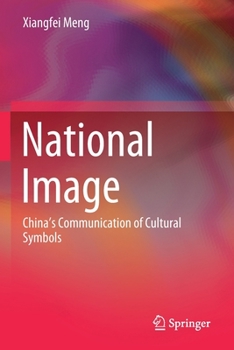National Image: China's Communication of Cultural Symbols
INTRODUCTION CHAPTER 1 AN OVERVIEW OF THEORIES OF NATIONAL IMAGE 1.1 THE FUNDAMENTAL CONNOTATION OF NATIONAL IMAGE 1.1.1 Introducing National Image 1.1.2 The Connotations of National Image 1.2 THE FUNCTIONS AND EFFECTS OF NATIONAL IMAGE 1.2.1 National Image is an Important Part of National "Soft Power" 1.2.2 A Positive National Image Can Boost International Discourse Power CHAPTER 2 PERCEPTUAL BARRIERS TO CHINA'S NATIONAL IMAGE AND THEIR CAUSES 2.1 HISTORICAL SHIFTS IN CHINA'S NATIONAL IMAGE 2.1.1 The Stage of Admiration: Prosperous, Diligent, Valiant 2.1.2 The Stage of Degradation: Closed, Backward, Ugly 2.1.3 The Degradation-Rapport Stage: Red, Frenzied, Miraculous 2.2 THE PERCEPTUAL BARRIERS TO THE NATIONAL IMAGE OF CONTEMPORARY CHINA 2.2.1 The National Image of Contemporary China in a Negative Light 2.2.2 The National Image of Contemporary China in a Positive Light 2.2.3 Trend of Contemporary China's National Image 2.3 A CAUSAL ANALYSIS OF THE PERCEPTUAL DISCREPANCY IN CHINA'S NATIONAL IMAGE 2.3.1 The Political Factor: the "Western-Centrism" Position2.3.2 The Cultural Factors: Cultural Differences and Symbol Barriers 2.3.3 The Media Factors: Hegemonic Discourse & "Loss of Voice" CHAPTER 3 NATIONAL IMAGE FROM A CONSTRUCTIVIST PERSPECTIVE 3.1 INSIGHTS INTO CONSTRUCTING NATIONAL IMAGE FROM CONSTRUCTIVISM 3.1.1 Shared Ideas (Knowledge) 3.1.2 State Identity (Interests) 3.1.3 Holism (Structures) 3.2 A CONSTRUCTIVIST INTERPRETATION OF NATIONAL IMAGE3.2.1 Model of Construction: Communication → Shared Ideas → National Image 3.2.2 Intersubjectivity: "Self-built Image" & "Others-built Image" with Mass Media as Intermediary 3.2.3 The Age of Simulacrum: Information Game and Symbol Contest CHAPTER 4 THE APPLICATION OF CULTURAL SYMBOLS AND THE MISUNDERSTANDING OF CULTURAL SYMBOLS 1334.1 GENERAL ANALYSIS OF SYMBOLS 4.1.1 Implications and Functions of Symbols 4.1.2 Symbols and the Communication of National Image 4.2 APPLICATION OF CULTURAL SYMBOLS IN THE CONSTRUCTION OF NATIONAL IMAGE 4.2.1 Connotations and Definitions of Cultural Symbols 4.2.2 Hollywood Movies and the National Image of the United States 4.2.3 Japanese Animation Industry and the National Image of Japan 4.2.4 Korean Wave and the National Image of South Korea 4.3 INTERCULTURAL COMMUNICATION AND MISUNDERSTANDINGS OF CHINESE CULTURAL SYMBOLS 4.3.1 Misunderstanding of China's National Image Caused by Improper Cultural Symbols 4.3.2 The Inevitable Lack of "The Common Field of Experience" 4.3.3 Case analysis CHAPTER 5 THE INTERNATIONAL COMMUNICATION OF CULTURAL SYMBOLS IN THE CONSTRUCTION OF CHINA'S NATIONAL IMAGE 5.1 THE VALUE ORIENTATIONS OF CULTURAL SYMBOLS IN THE CONSTRUCTION OF CHINA'S NATIONAL IMAGE 5.1.1 Construct the National Image underlining Peaceful Development 5.1.2 Construct the National Image Highlighting Independence and Seeking Common Ground while Shelving Differences 5.1.3 Construct the Image of a Major and Responsible Country 5.2 THE PRINCIPLES OF SELECTING CULTURAL SYMBOLS TO CONSTRUCT CHINA'S NATIONAL IMAGE 5.2.1 The Principle of Reflecting National Characteristics 5.2.2 The Principle of Universality 5.2.3 The Principle of Synergizing Past, Presence and Future 5.2.4 The Principle of Being Consistent with the Positioning of Core National Image 5.3 THE COMMUNICATION STRATEGIES FOR CULTURAL SYMBOLS IN THE CONSTRUCTION OF CHINA'S NATIONAL IMAGE
Format:Paperback
Language:English
ISBN:9811531498
ISBN13:9789811531491
Release Date:March 2021
Publisher:Springer
Length:216 Pages
Weight:0.76 lbs.
Dimensions:0.5" x 6.1" x 9.2"
Customer Reviews
0 rating





